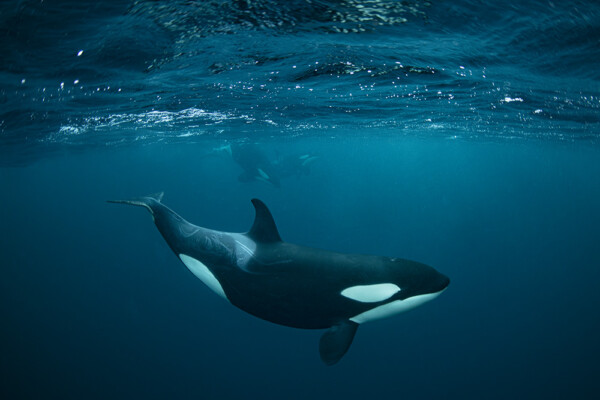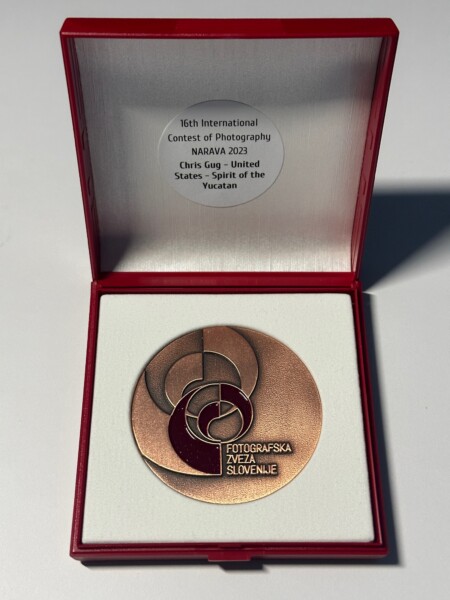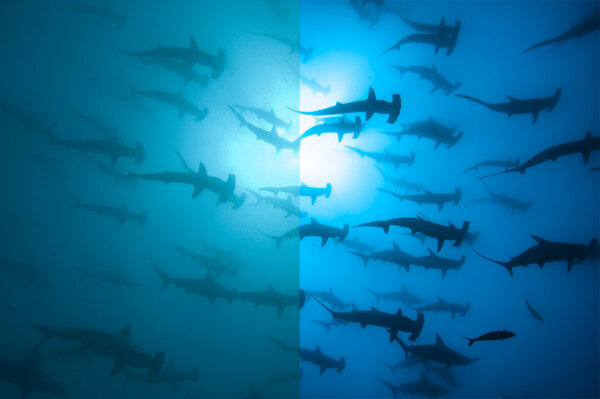When you think of the destinations that an underwater photographer dreams of, Norway doesn’t generally make the list. But there are simply some things a guy can’t find in the tropics. And in the past few years, I’ve had good reason for moving large apex predators, such as orcas, up to the top of my photographic bucket list – the world has been getting smaller by the year, and opportunities are being forcefully taken off my plate as fast as I can dream up the ideas behind them. So, let me regale you with a little story about Norway, and the most awesome animal encounter of my life!
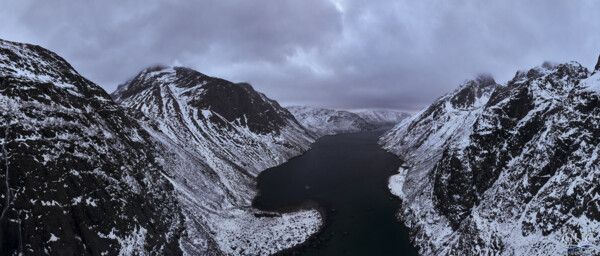
But first, we start on dry land. Frozen, frigid, windy dry land. After a quick flight from Miami to Oslo, and an even quicker Oslo to Alta, I looked at my rental car, and saw something wrong with the tires – they had all these little nailheads sticking out of them! Hundreds, in fact! I’ve lived my whole adult life in the tropics, and I don’t know a damn thing about driving on snow and ice, but here I am, with a 4×4 Rav-4 with studded tires… what could go wrong?
For well over a year, I’ve been reading astronomy articles about the upcoming “Solar Maximum” – a bell-curved period peaking in November 2024 when Earth would be receiving the greatest amount of solar radiation in several decades. We’ve all heard headlines in the months leading up to this point where the Northern Lights (aka Aurora Borealis) have been visible much further south than normal, and we timed this trip to be in the ideal latitude and during the new moon phase for the darkest skies, so that we could spend a week chasing the northern lights before our week chasing the orcas. “Chasing the northern lights” is a bit of a misnomer – “chasing clear skies” is a bit more accurate, and watching the cloud forecast became as much of an obsession, as scouting for foreground subjects to be under the light show that I hoped would come later that night. Fortunately, the sun only clears the horizon at this altitude (~200 miles north of the Arctic Circle) for about 3.5 hours per day, so by 6pm, it’s complete darkness, as the astronomical twilight has already given way to full night. That gives a loooong night for the hunt!
Night one provided a pleasant surprise with mostly clear skies and a decent show. Just enough for me to fix my mistakes with the camera, and finally get a few decent shots towards the end of the night. But the overcast skies eventually won out. Night two was similar – dodging massive patches of cloud cover, and seeking the few upward holes, while fingertips, toes, and faces begin to feel like they’re being cut with razorblades as the cold eventually wins the nightly battle. Night three, we covered countless miles inland, almost to the boarder of Finland, but couldn’t get around the cloud cover. But then on night 4, what started as a “hey, here’s some clear sky, let’s set up and see if we can get a reflection shot over this icy lake”, quickly turned into Mother Nature’s greatest above-water spectacle on Earth. What started as a little trickle of green overhead, morphed into a river, and eventually a writhing carpet that stretched from horizon to horizon. Firing off shots as fast as I could, my fingers felt ready to crack off from the cold, but as we were on a small peninsula, I kept finding it advantageous to run from one side back to the other, helping maintain my core temperature. I was so afraid that it would soon be over, I needed to nail as many compositions as possible, because I just KNEW it was too good to last! 2 hours later, neither the light show, nor my enthusiasm had faded even a bit! Like a mostly green lava lamp, the shape shifted constantly, and occasionally, there’d be a burst of red & purple. Several times, we were even treated to “curtains”, which is perhaps the most beautiful shape. And several times, I remembered to stop shooting, and Suzanne & I would just lay on our backs, alone in the Arctic wilderness, stare up into the sky, and remember to appreciate how amazing this world can be.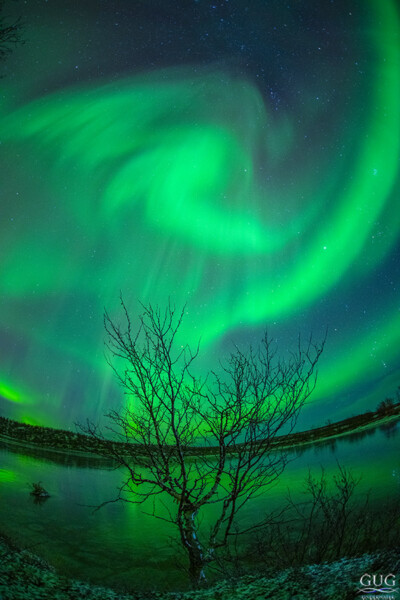
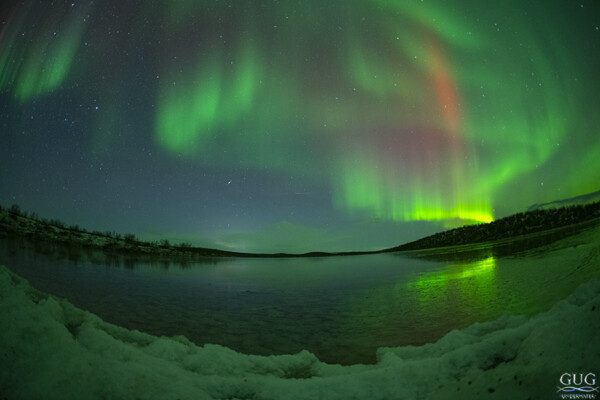
Two more nights of overcast made for lackluster northern lights, but could anything ever compare to what we had the night before? Finally, it was time to return the car, and board the boat to begin the hunt for the orcas. We’d be on this boat for the next week, cruising through the fjords to the northernmost tip of Norway. Where there were schools of herring, there’d be whales. Of course, orcas are not whales, but rather the largest of the dolphins. But there were also humpback whales, fin whales, Bryde’s whales, and plenty of others sharing the fjords and following the herring migration. And while photographing the “killer whales” while feeding on the herring was the objective of the expedition, any chance to film the other whale species would be a welcome treat.
Day 1 & 2 proved challenging. Strong winds made it impossible to leave the large boat with the smaller dinghy. Whitecaps made it difficult to see the “blows” or the dorsal fins breaking the surface. We spent almost all of the available daylight hours in the wheelhouse scanning the horizon, but in two whole days (mind you, that’s realistically only a ~4-hour window because of the low sun), we only saw a large group of humpbacks travelling, and a lone sperm whale taking a few breaths before a long dive. Still, weather prohibited launching the dinghy, so we just marveled from just outside the wheelhouse until our eyeballs froze.
Day 3 was a bit calmer, but the orcas were still nowhere to be found. We spent 2 hours cruising on the small dinghy in search, and eventually, we found a small travelling pod. Travelers are unlikely to give a quality encounter (obviously, because they’re going somewhere), but it was a good opportunity for a quick fly-by where I was able to check the results on my camera later that night. Lucky I did, because little did I know that tomorrow would be one of the greatest wildlife encounters of my life.
Day 4 began slowly with a few orcas here & there, easily spotted by their massive dorsal fins cutting the surface and exhalation blows. We tried a few different pods, but they weren’t interested, and we’re not going to pester or chase orcas who don’t want us there. But then, with only a few hours of reasonable daylight remaining…. birds! Far in the distance, at the very extent of vision, the seagulls were dive-bombing, and commotion could be seen at the surface. We raced the dinghy full-bore towards the action, and in a very similar manner to last week’s northern lights bonanza night, I prepared myself to nail shots as quickly as I could, as realistically, this encounter might last only a few brief minutes. A common challenge, is that as soon as a humpback hears the commotion, they sneak-attack with mouth agape from below, and consume the entire baitball of herring in one single gulp. Game over. So whereas I’d love to get that shot (like on the Trip to Magdelena Bay, Mexico in Dec 2023), my fingers were crossed for no humpbacks!
By the time we reached the baitball (sidebar – I’m sure herring hate being called a baitball – I always imagine them saying, “what do you mean…..baitball?!?!?”) I was ready to go. The moment the dinghy got within swimming range, I slid in as quietly as possible (in other words, with a moderate, clumsy splash, due to the cumbersome drysuit and my massive camera), and slowly finned my way towards where the seagulls were dive-bombing. And there it was – thousands of herring, probably numbering around 10,000, writhing in a tight spiraling orb, about 15’ below the surface. But where were the orcas? I could hear them, even through my thick hood. I had just seen dorsal fins and blows minutes before…OH THERE THEY ARE!!!! From out of the blue-grey haze of the already low light, they came like rockets, bursting through the herring, pushing the baitball up towards the surface. And the slowly falling scales of munched herring rained down underwater, just as the snowflakes fell from the sky up above, as the 8” fish did their best to stay together in a tight ball – their only defense against the hyper-intelligent predators who outmatched them in every way.
In the Norwegian fjords, orcas have a unique method of feeding. They swim up to the baitball of herring, and appear to turn 90-degrees vertical. But their tail continues the vertical spiral, and creates a shockwave that stuns between 10-50 herring. The orca then swims back and takes one fish at a time into it’s mouth, and with it’s nimble tongue, separates the fatty, protein-rich parts from the skull, backbone, and gassy swim bladder. The dexterity required for this feat is amazing – it’s the equivalent of tying a knot in a cherry using your tongue. The herring carcass, with the buoyant swim bladder intact, then floats to the surface, which is what the seagulls have been going bonkers over. And every so often, a herring who had been stunned, but not yet eaten, floated right past my face. I kept wondering if it was risky, having a stunned fish right in front of me – what if an orca wanted it? Would it think I was stealing it’s food?
But the more Suzanne & I observed them at dinnertime, the more we learned about their social behavior. They would take turns tail-slapping the baitball, and instead of rushing in to greedily grab as many fish as possible, they communicated with each other, and slowly took turns. Mothers would gently bring herring to their calves, and patiently watch to ensure they executed the correct technique. Gigantic males with enormous dorsal fins would approach a stunned herring, but then suddenly stop to yield to a smaller member of the pod. Each orca got their fill. There was no competition. It was a cooperative effort by all adult members of the pod, and each member was looking out for each other, ensuring everyone got their fill, constantly communicating through chirps, buzzing, and clicks – a language that we haven’t even begun to decode.
And with those chirps, buzzing, and clicks, they would also pause to scan us. Having a highly intelligent apex predator looking directly at me while scanning my body with a form of echolocation that defies even human’s best technology, should probably be intimidating. But never once did I feel threatened. Having them scan my body with their sonar instead felt like an honor. With their eyes staring straight into mine, they showed genuine curiosity as to what I was, why I was there, and why I’m too slow to catch a herring. But never, ever was there any feeling of intimidation or threatening body language. Similarly to my 8 years working with the North Atlantic humpback whales, when the orcas projected their sonar at me, not only could I feel it resonating in the air-space behind my camera housing’s 9.5” dome port, but also in my lungs and other air spaces in my ears and sinuses. What a privilege it is to feel the non-verbal language of a separate species who is trying to learn about me! 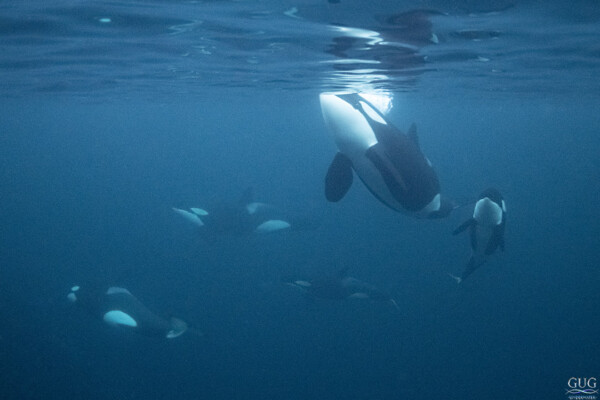
Over two hours flew by in the blink of an eye, and now over an hour past the slow sunset, I had pushed my camera to ISO 8000 in an attempt to overcome the darkness. The GoPro I had mounted to the top of my main camera housing was now producing almost black footage. And the whole time, we and the dinghy driver were absolutely amazed that a humpback hadn’t come and wrecked the encounter. Having this much time getting to observe a feeding pod, who also took time to interact with us in the water, was like getting dealt a royal flush in poker – we truly lucked out, and the adrenaline-fueled high lasted not just into the night, but for days – even now, 10 days later, my fingers tremble a bit as I’m writing this, with my mind going back to staring into a bull’s eyes, and it staring back into mine, as we both appreciate each other and wonder what the other is thinking.
The next two days were just as overcast, and the wind increased yet again, making it difficult to go out in search of orcas with the dinghy. But on the next night, one of the boat crew mentioned that he’s dove throughout these fjords, and when I asked if he’d ever seen my dream fish – the goosefish – he replied, “sure – all the time!”. Next thing you know, I’m borrowing his scuba gear and doing a solo night dive 250 miles north of the Arctic Circle in search of my first goosefish! And while I didn’t find one, I did marvel at the abundant invertebrate life and fish that existed in the fjords. Brittle starfish coated the rocky/sandy sea floor. Bushes of hydroids hosted massive 1” skeleton shrimp. Halibut & flounder lying on the sea floor were abundant. Other fish that are unknown to me were sometimes attracted to my lights, while other times repulsed by them. And my prize find was an intermediate-stage wolf eel! At this adolescent age, it was about 16”, and had neither the orange color of the juveniles, nor the purple hue of the adults (which can grow to 7’), but rather a greyish-brown coloration that I had never seen before.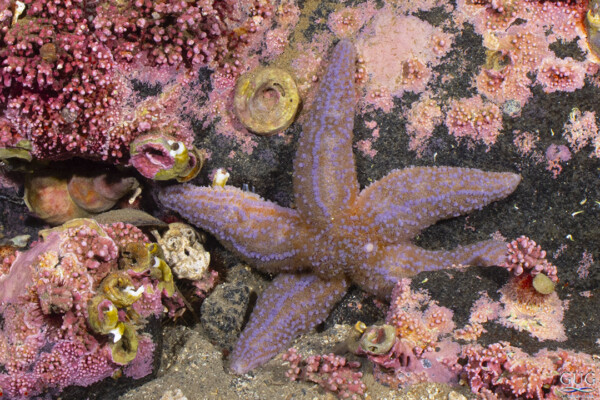
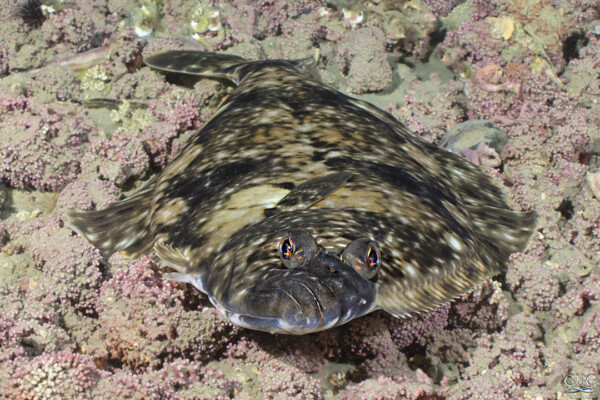
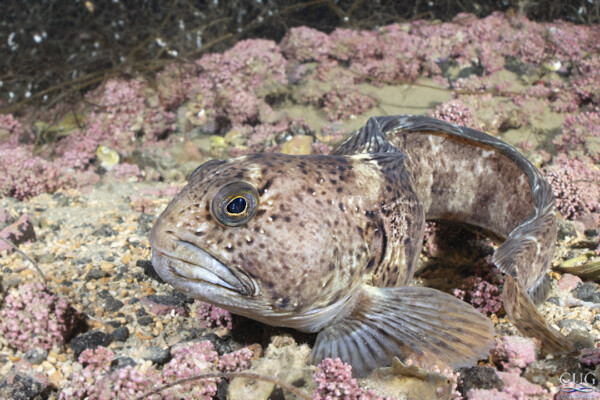
So essentially, a week out at sea, freezing and bouncing, searching and waiting – it all produced one single amazing encounter. On one hand, I expected multiple close encounters – perhaps or so, but I expected each of them to last perhaps 10-20 seconds. Instead, I got two 10-second fly-by’s, and one experience that lasted over two hours. I’ll call that a win! The experience was not easy, nor was it glamorous, and at times, it was pretty miserable. But the one encounter made any negativity outright irrelevant. I’ll cherish it for the rest of my life, and if I were to return to do it again, I likely won’t get anything close to my one lucky day.
I mentioned earlier that one of the primary reasons for moving orcas to the top of my bucket list is because access to several aquatic apex predators has been taken away in the past few years, and I believe more will join that list as time goes on. The Internet, and in particular, Instagram and other social media, for all their positive aspects, are continually making the world a smaller place, and sucking the mystery and awe and wonder out of the world. More people see more amazing things, and want to go to amazing places, and do it for The Gram. For every 10 responsible travelers, there’s one who does it irresponsibly, or sometimes, it’s an eco-tourism operator who pushes the envelope with inexperienced people in a way that eventually hurts either the human, or the animal they’ve come to see. Such has been the case with the great white sharks of Guadalupe, with the crocodiles of Chinchorro, the oceanic white tip sharks of the Red Sea, the whale sharks of Isla Mujeres and plenty of others – even Pig Island in the Bahamas has become somewhat of a circus, with Instagram bikini models getting bit in the butt after stealing piglets from their mamas on the regular. Eventually, rules need to be created, tourism exceeds critical mass, and rules get broken (so often for The Gram), and then once someone or the animal gets injured, the government steps in and cuts off all access. I feel this will eventually happen with the orcas. And I’m glad I was able to do it in a way that was just as fascinating for me, as I feel it was for the orcas who returned my gaze and scanned me with their sonar. I hope there’s a few orcas out there right now, telling their friends about the humans they saw who were so slow that they just floated there and never even caught a single fish, but instead, held a big metal and glass object in front of their face that made a slight clicking sound, and occasionally lowered it to stare back into their eyes. How I wish I could explain my photography to them! How I wish I could impress upon them how beautiful I felt they are! How I wish I could tell them that I traveled across the Earth for the chance to spend just a few minutes in their world!
New Release in the Fish Faces Collection –Artic Freedom
